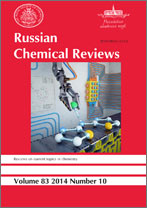|
This article is cited in 25 scientific papers (total in 25 papers)
Structural and configurational relationships 'metal complex–substrate–product' in asymmetric catalytic hydrogenation, hydrosilylation and cross-coupling reactions
V. A. Pavlov
N. D. Zelinskii Institute of Organic Chemistry, Moscow
Abstract:
The present-day published data on the relationships between the structures of rhodium, iridium, ruthenium, nickel and cobalt catalytic complexes and substrates in homogeneous asymmetric hydrogenation, hydrosilylation and cross-coupling reactions are systematised. The optimum ratio between the number of coordination vacancies in the complex and the number of functional groups of the substrate has been characterised in terms of a criterion of maximum enantioselectivity of the catalytic complex. The relationships between the configurations of the complexes and the products formed in the reactions are analysed. In the case of C2-symmetrical chiral diphosphine complexes as catalysts (some structural elements of their ligands represent an incomplete turn of a helix surrounding the central metal atoms), substrates of the same kind form the products having definite configurations characteristic of the particular orientation of the helix. For example, rhodium complexes with ligands that form an incomplete P-helical turn around metal atoms catalyse the formation of (R)-amino acids from the corresponding precursors. If the ligands contain fragments of M-helices around rhodium atoms, it is (S)-amino acids that are formed. The bibliography includes 234 references.
Received: 25.04.2001
Citation:
V. A. Pavlov, “Structural and configurational relationships 'metal complex–substrate–product' in asymmetric catalytic hydrogenation, hydrosilylation and cross-coupling reactions”, Usp. Khim., 70:12 (2001), 1175–1205; Russian Chem. Reviews, 70:12 (2001), 1037–1065
Linking options:
https://www.mathnet.ru/eng/rcr783https://doi.org/10.1070/RC2001v070n12ABEH000676 https://www.mathnet.ru/eng/rcr/v70/i12/p1175
|


| Statistics & downloads: |
| Abstract page: | 98 |
|





 Contact us:
Contact us: Terms of Use
Terms of Use
 Registration to the website
Registration to the website Logotypes
Logotypes








